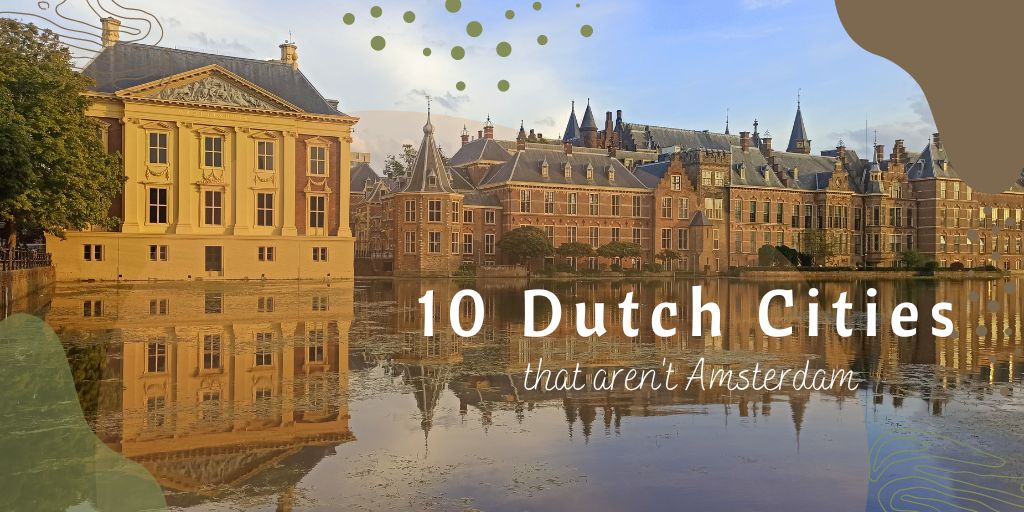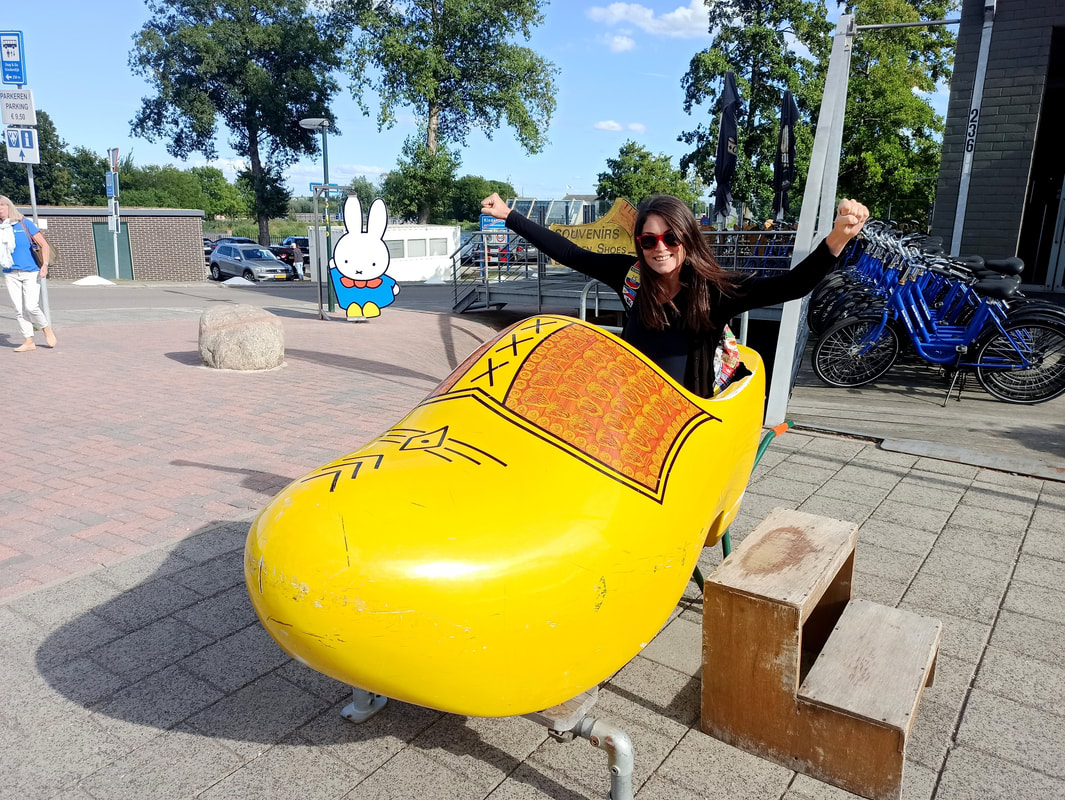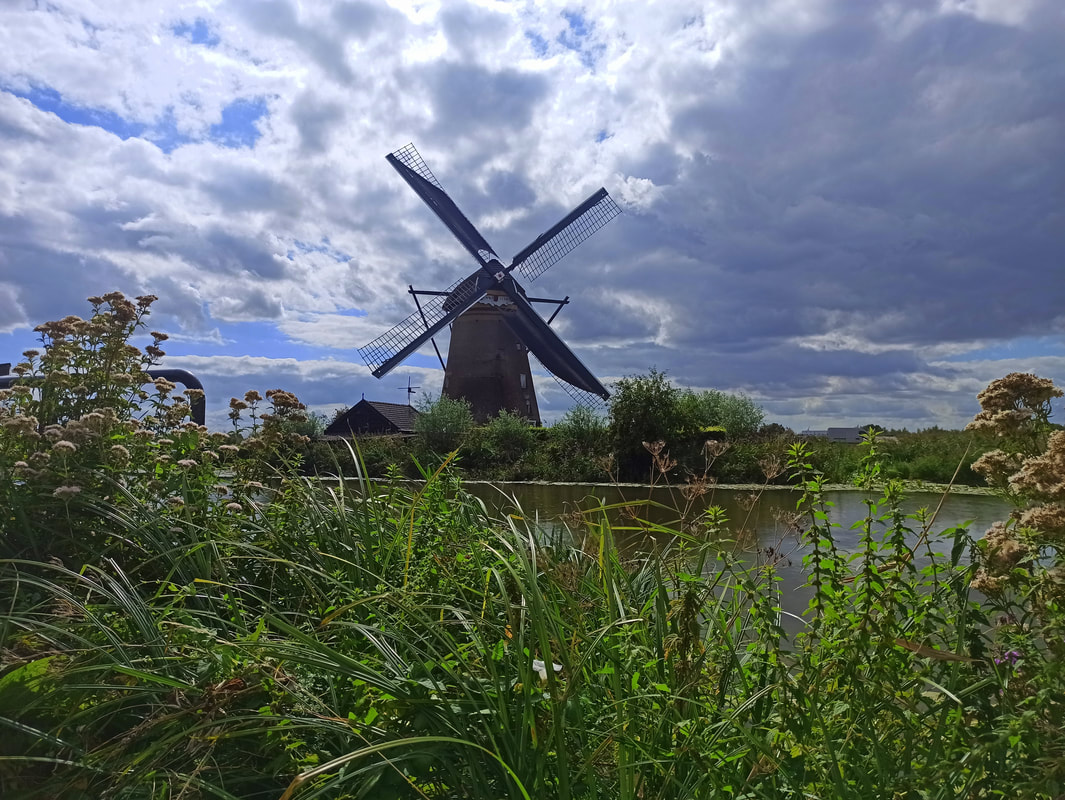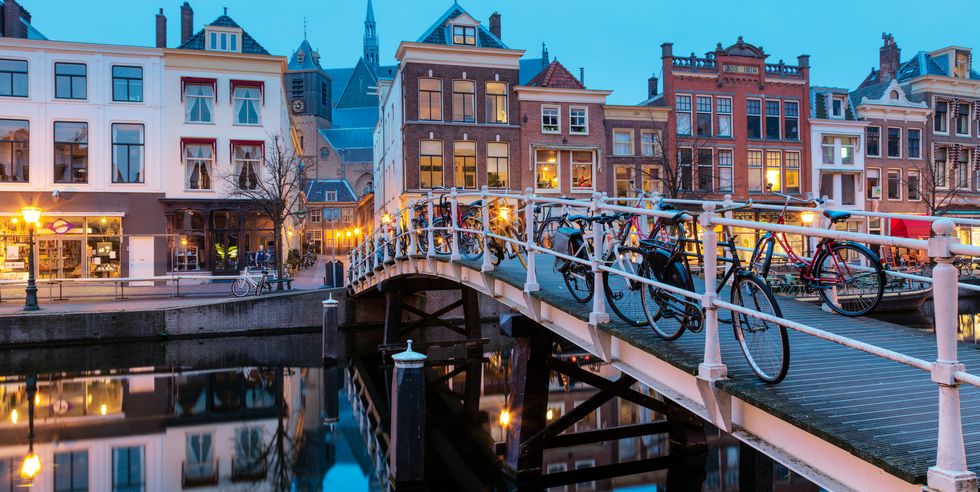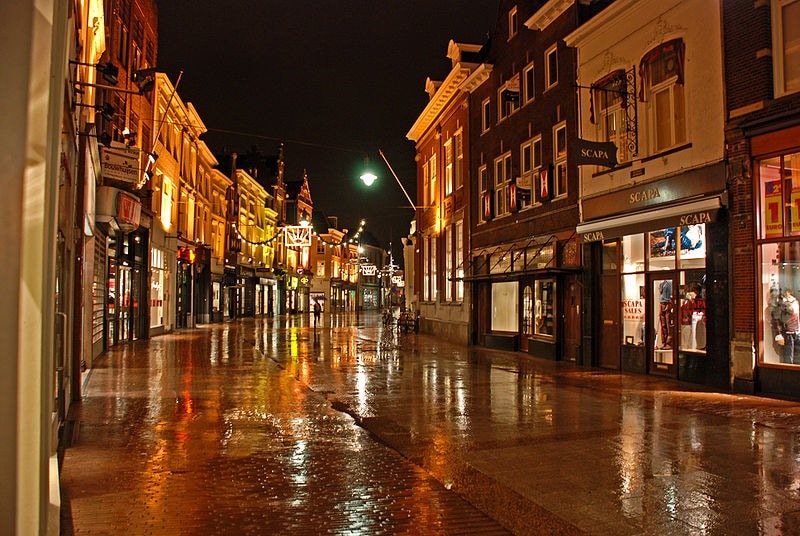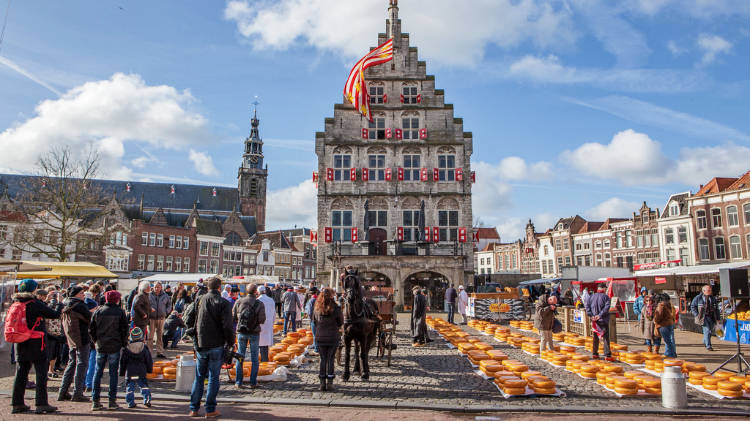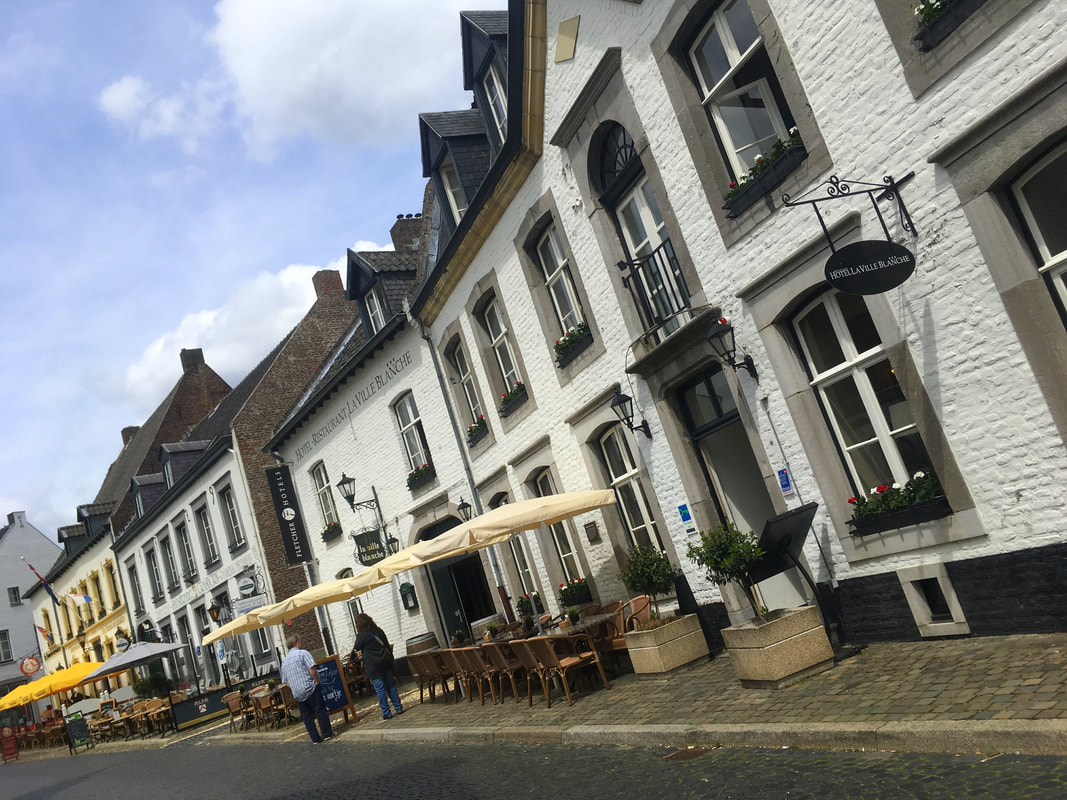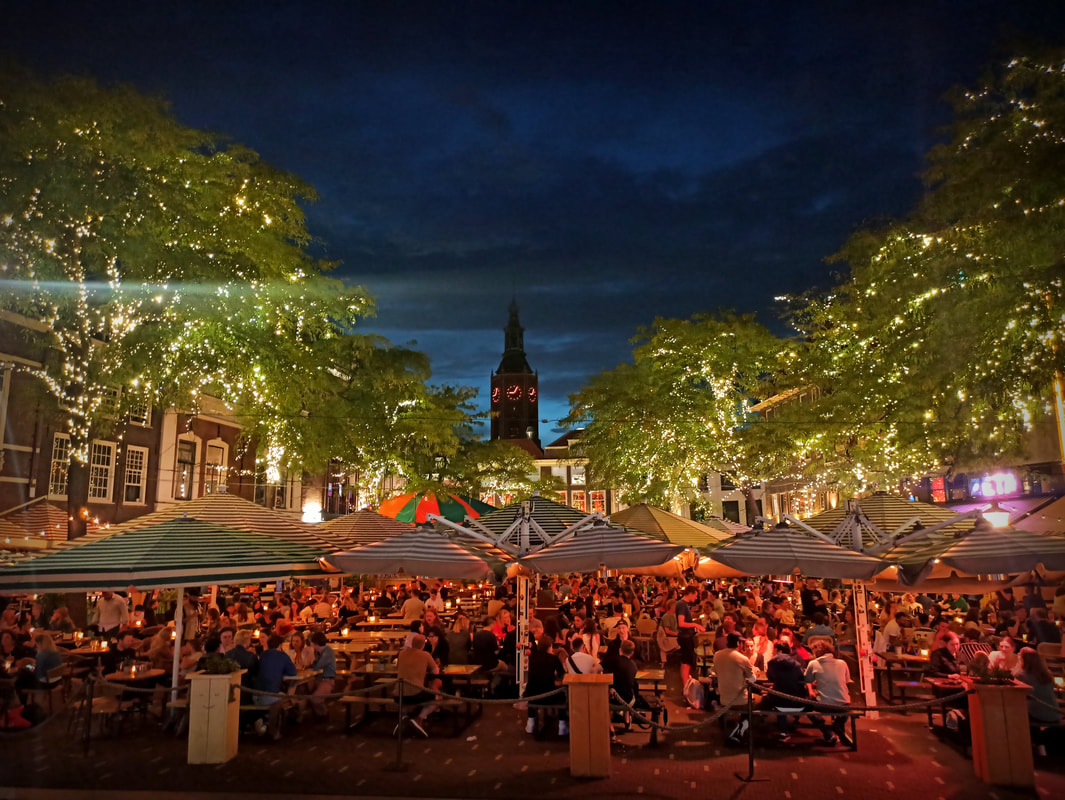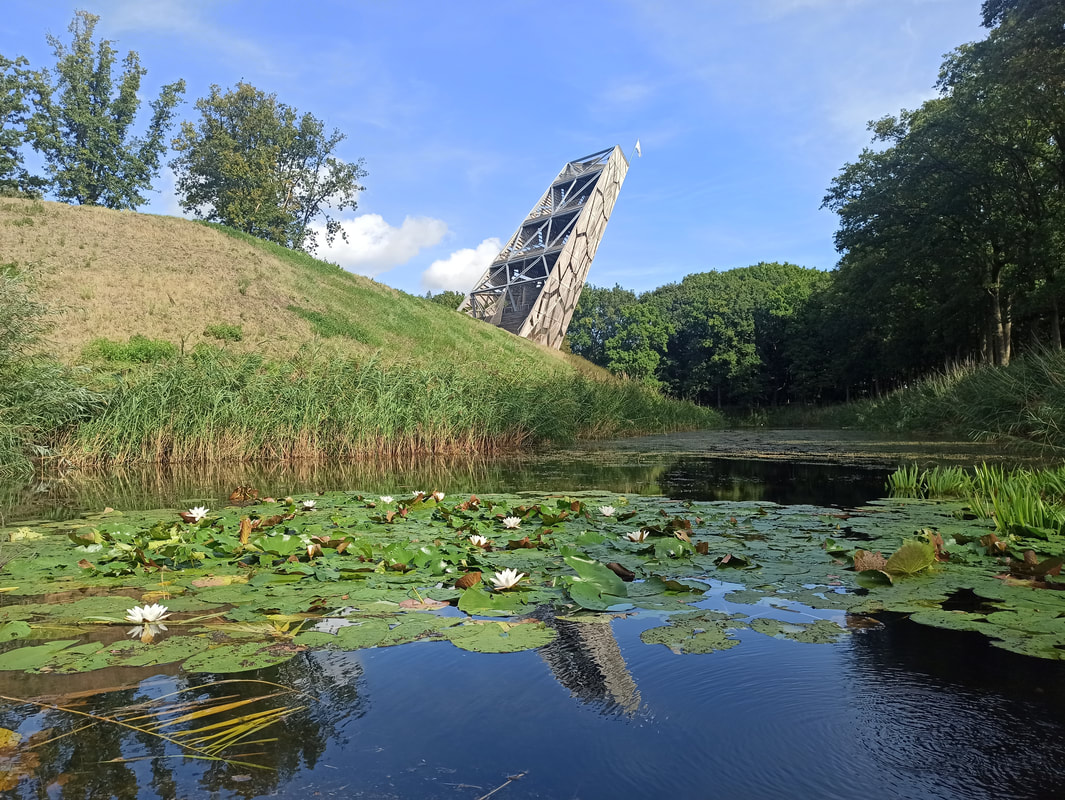10 Dutch Cities That Aren't Amsterdam
Not in the story-mood? Scroll down for the Quick Budget Fact Overview: an itemized information summary of the Netherlands↓
It’s the most common question when traveling: “Where are you from?” Over and over, coming out of the mouths of an ongoing stream of strangers you never talked to before and you’ll likely never talk to again. So, to answer that question: I was born in The Netherlands, a name that many foreigners don’t recognize unless I follow up with: “Holland” (Poland? No, Hhhhholland). Yet, Holland is not a country. It’s the not-even-complete-name of 2 (out of 12) different provinces: North Holland and South Holland. As our capital Amsterdam is located in the province of North Holland it is in fact true that 99% of all tourists do visit Holland within The Netherlands… and then limit their visit to that city only, to subsequently claim they saw my country. Of course, its reputation swiftly spread out on a global level… I mean, it’s the capital of that tiny, almost-invisible-on-the-map country which was the first one worldwide to legalize marihuana, prostitution and same-sex marriage (far before Netflix made it cool). What’s not to like?
However, like everywhere else, the capital is everything the rest of the country is not. Yes, there are “coffee shops” in most cities, but not 5 in every street block and honestly, I hardly knew anyone during 27 years of living in The Netherlands who made a habit out of smoking weed (I mean, it was legal which equals boring). Yes, ladies of the night are completely normalized and even have their own trade union, but it’s a reality far away from the average provincial citizen (most of these legally employed women are foreigners anyway). Most Dutch people go to Amsterdam to have fun, go out and go crazy, and then go back to their normal lives, very much like yourself.
Curious what these normal lives in normal towns look like? You should be, as that’s what traveling is all about. Let me enlighten you with a selection of Dutch towns that are NOT Amsterdam… but equally good- or even better-looking, their streets uncontaminated with dead-drunk members of stag parties and with a slightly smaller chance to be run over by a hasted cyclist.
10 Dutch Cities That Aren’t Amsterdam
Curious what these normal lives in normal towns look like? You should be, as that’s what traveling is all about. Let me enlighten you with a selection of Dutch towns that are NOT Amsterdam… but equally good- or even better-looking, their streets uncontaminated with dead-drunk members of stag parties and with a slightly smaller chance to be run over by a hasted cyclist.
10 Dutch Cities That Aren’t Amsterdam
1: Haarlem
An easy one to start with for me: Haarlem. The capital of the province of North Holland (yup, NOT Amsterdam) and my absolute favorite city in The Netherlands. I loved this place so much that I eventually packed up all my shit and moved there. I ended up staying for 3.5 years, which in my life equals several eternities combined, right up until when the call for traveling became close to deafening (the only way I could ever leave Haarlem was by leaving the country altogether). To rewind to the origins of this pleasant life chapter: I needed to escape the madhouse of Amsterdam where I lived for a year, as I naively thought that’s where all cool people were supposed to go… However, this was a place which left me riled up with stress, anxiety and loneliness (in quiet places where I am actually alone I am never lonely… loneliness manifests itself in crowded places consisting of people you have no connection with). As a reward of my escape plan the universe granted me Haarlem: Amsterdam’s sexy yet deliciously old-fashioned neighbour where people still greet each other on the street. Streets embellished with the same astounding architecture as Amsterdam, yet instead of millions of tourists flocking in front of them you’ll see just the locals speeding by on their bicycles… almost unaware of the unique beauty surrounding them, because it’s everywhere and all the time. If you’d ask me what I like most about Haarlem you’d leave me in an awkward stutter. The majestic buildings withstanding the test of time when the cycles of life elope around them… The charming bridges spanning the Spaarne, cracking open in their centres or ingeniously rotating around their axes to give way to a scenic stream of recreational boats enjoying those scarce Dutch sunny days… Or maybe the close proximity to the Zuid-Kennemerland National Park and the long sand beaches bordering the North Sea, combining the pleasures of a city with my need for nature? This place defines all that I like about my country, while simultaneously denying what I don’t miss at all.
* By the way, don’t ever dare thinking Haarlem was named after the Harlem district in New York. It was exactly the other way around (remember that New York was once New Amsterdam?).
Recommended Sights: Teyler Museum; Frans Hals Museum; Haarlem Museum; Dolhuys Museum; Corrie ten Boom House Museum; Jopenkerk Brewery; St. Bavo Cathedral; Grote Markt (Main Square); Botermarkt; City Hall; Vleeshal; Vishal; Hofjes (Courts); De Adriaan Windmill; Bridges over Spaarne River; Haarlem Railway Station; Amsterdam Gate.
Check out my full Haarlem Blog here!
An easy one to start with for me: Haarlem. The capital of the province of North Holland (yup, NOT Amsterdam) and my absolute favorite city in The Netherlands. I loved this place so much that I eventually packed up all my shit and moved there. I ended up staying for 3.5 years, which in my life equals several eternities combined, right up until when the call for traveling became close to deafening (the only way I could ever leave Haarlem was by leaving the country altogether). To rewind to the origins of this pleasant life chapter: I needed to escape the madhouse of Amsterdam where I lived for a year, as I naively thought that’s where all cool people were supposed to go… However, this was a place which left me riled up with stress, anxiety and loneliness (in quiet places where I am actually alone I am never lonely… loneliness manifests itself in crowded places consisting of people you have no connection with). As a reward of my escape plan the universe granted me Haarlem: Amsterdam’s sexy yet deliciously old-fashioned neighbour where people still greet each other on the street. Streets embellished with the same astounding architecture as Amsterdam, yet instead of millions of tourists flocking in front of them you’ll see just the locals speeding by on their bicycles… almost unaware of the unique beauty surrounding them, because it’s everywhere and all the time. If you’d ask me what I like most about Haarlem you’d leave me in an awkward stutter. The majestic buildings withstanding the test of time when the cycles of life elope around them… The charming bridges spanning the Spaarne, cracking open in their centres or ingeniously rotating around their axes to give way to a scenic stream of recreational boats enjoying those scarce Dutch sunny days… Or maybe the close proximity to the Zuid-Kennemerland National Park and the long sand beaches bordering the North Sea, combining the pleasures of a city with my need for nature? This place defines all that I like about my country, while simultaneously denying what I don’t miss at all.
* By the way, don’t ever dare thinking Haarlem was named after the Harlem district in New York. It was exactly the other way around (remember that New York was once New Amsterdam?).
Recommended Sights: Teyler Museum; Frans Hals Museum; Haarlem Museum; Dolhuys Museum; Corrie ten Boom House Museum; Jopenkerk Brewery; St. Bavo Cathedral; Grote Markt (Main Square); Botermarkt; City Hall; Vleeshal; Vishal; Hofjes (Courts); De Adriaan Windmill; Bridges over Spaarne River; Haarlem Railway Station; Amsterdam Gate.
Check out my full Haarlem Blog here!
2: Leiden
If Haarlem wouldn’t have existed, I would have moved to Leiden instead. This place is not only a stunning time capsule of what can be qualified as “typically Dutch,” including the expected canals, bridges and historical monuments (it was in fact Rembrandt’s hometown)… It’s the energy of this city that elevates the spirit of any tourist adventurous enough to deviate from the beaten path to pay Leiden a visit. You see, Leiden is a typical university town. Now, that’s not too special in its own right… there are many universities in the Netherlands, from Rotterdam to Tilburg to Wageningen… but in Leiden the student ambience is what defines the very soul of the city. You feel that curiosity, the spunk of youth, the celebration of twenty-somethings finally escaping that parental authority to confront life on their own two feet. Leiden feels young, wild and free. Exactly that makes the experience so complete: During the day you can find yourself culture-vulturing around town, hopping in and out of its many museums and studying the thrilling architectural details. Yet, when night falls, the music and laughter coming from the bars (as well as the cheap student beer deals) will lure you straight into a night of fun and bad decisions.
Recommended Sights: Rijksmuseum van Oudheden; Museum Volkkunde; Rijksmuseum Boerhaave; American Pilgrim Museum; Naturalis Biodiversity Center; Museum De Lakenhal; Sieboldhuis Museum; Japan Museum; Wevershuis Museum; Young Rembrandt Studio; Corpus Museum; Molenmuseum De Valk; De Put Windmill; Botanical Gardens; De Burght; Gravensteen; Oude Sterrenwacht (observatorium); Muurgedichten (Wall Poems); River Rhine; Hooglandse Kerk (church); Pieterskerk (church); Leidse Hout Park; Koornbrug (bridge); City Hall; Hofjes (courtyards).
If Haarlem wouldn’t have existed, I would have moved to Leiden instead. This place is not only a stunning time capsule of what can be qualified as “typically Dutch,” including the expected canals, bridges and historical monuments (it was in fact Rembrandt’s hometown)… It’s the energy of this city that elevates the spirit of any tourist adventurous enough to deviate from the beaten path to pay Leiden a visit. You see, Leiden is a typical university town. Now, that’s not too special in its own right… there are many universities in the Netherlands, from Rotterdam to Tilburg to Wageningen… but in Leiden the student ambience is what defines the very soul of the city. You feel that curiosity, the spunk of youth, the celebration of twenty-somethings finally escaping that parental authority to confront life on their own two feet. Leiden feels young, wild and free. Exactly that makes the experience so complete: During the day you can find yourself culture-vulturing around town, hopping in and out of its many museums and studying the thrilling architectural details. Yet, when night falls, the music and laughter coming from the bars (as well as the cheap student beer deals) will lure you straight into a night of fun and bad decisions.
Recommended Sights: Rijksmuseum van Oudheden; Museum Volkkunde; Rijksmuseum Boerhaave; American Pilgrim Museum; Naturalis Biodiversity Center; Museum De Lakenhal; Sieboldhuis Museum; Japan Museum; Wevershuis Museum; Young Rembrandt Studio; Corpus Museum; Molenmuseum De Valk; De Put Windmill; Botanical Gardens; De Burght; Gravensteen; Oude Sterrenwacht (observatorium); Muurgedichten (Wall Poems); River Rhine; Hooglandse Kerk (church); Pieterskerk (church); Leidse Hout Park; Koornbrug (bridge); City Hall; Hofjes (courtyards).
Source
3: Den Bosch
Or, to make it close to unpronounceable for you: ‘s Hertogenbosch, which is old-fashioned Dutch for “the forest of the duke”… the duke in question being Henry I of Brabant, who founded the town on a bunch of forested dunes in the middle of a marshland and then granted them some city rights. Well, thanks to our boy Henry the province of Noord-Brabant got a place that grew out to be their most good-looking city. Subjectively speaking of course, but you’ll agree with me anyway. The most remarkable aspect of Den Bosch’s delightful architecture, is that it can even be admired from below. A boat ride is always a good idea, in any town you end up getting stranded in The Netherlands… but nowhere it’s as intriguing as in Den Bosch, where parts of the canals lead you under the city. Combine that adventure with lively streets full of cosy restaurants and cafes, several natural reserves surrounding the city, and a vast collection of museums… one of them inevitably dedicated to its most renowned citizen: painter Jeroen (or fancy: Jheronimus) Bosch, his works easily recognizable by the comical figurines representing vivid scenes of life and death, heaven and hell. A day in Den Bosch is a day well spent.
Recommended Sights: St. Jans Cathedral; Grote Kerk (Church); Jheronimus Bosch Art Centre; Noord-Brabants Museum; Design Museum; Slager Museum; Kruithuis Museum; Oeteldonks Gemintemusejum; Brabanthallen; Bossche Markt (Main Square); Paleis ‘s Hertogenbosch; Bossche Broek Nature Reserve; De Moerputten Nature Reserve.
Check out my full Den Bosch Blog here!
3: Den Bosch
Or, to make it close to unpronounceable for you: ‘s Hertogenbosch, which is old-fashioned Dutch for “the forest of the duke”… the duke in question being Henry I of Brabant, who founded the town on a bunch of forested dunes in the middle of a marshland and then granted them some city rights. Well, thanks to our boy Henry the province of Noord-Brabant got a place that grew out to be their most good-looking city. Subjectively speaking of course, but you’ll agree with me anyway. The most remarkable aspect of Den Bosch’s delightful architecture, is that it can even be admired from below. A boat ride is always a good idea, in any town you end up getting stranded in The Netherlands… but nowhere it’s as intriguing as in Den Bosch, where parts of the canals lead you under the city. Combine that adventure with lively streets full of cosy restaurants and cafes, several natural reserves surrounding the city, and a vast collection of museums… one of them inevitably dedicated to its most renowned citizen: painter Jeroen (or fancy: Jheronimus) Bosch, his works easily recognizable by the comical figurines representing vivid scenes of life and death, heaven and hell. A day in Den Bosch is a day well spent.
Recommended Sights: St. Jans Cathedral; Grote Kerk (Church); Jheronimus Bosch Art Centre; Noord-Brabants Museum; Design Museum; Slager Museum; Kruithuis Museum; Oeteldonks Gemintemusejum; Brabanthallen; Bossche Markt (Main Square); Paleis ‘s Hertogenbosch; Bossche Broek Nature Reserve; De Moerputten Nature Reserve.
Check out my full Den Bosch Blog here!
Source
4: Maastricht
Admitted, a visit demands the necessary sacrifices. Not only is Maastricht completely out of the way of everything, the local dialect is also close to insufferable (in the southern province of Limburg they speak some gibberish the rest of the country does not understand, and they pronounce every sentence like a question). However, as a non-Dutch-speaking foreigner you wouldn’t notice that anyway, which is a clear win on your end. Now you can focus on the actual city, which is worth the 3-hour train ride to the far southern arm of the country, stretching out into Germany and Belgium. It was initially developed as a Roman Settlement (Mosam Trajectum – Maas Tricht) and subsequently developed into a religious, industrial and eventually a vivid cultural centre. As I’m a cultural buff and can definitely NOT appreciate modern eyesores such as Rotterdam and Eindhoven, you can expect every city on my list being a traditional, historical Dutch treasure… and Maastricht is definitely no exception! The town has no less than 1677 national heritage buildings, only competing with Amsterdam in quantity. Like Leiden, it’s a university city, but the accent lies more on the local culture of the original residents, who are famed for their Burgundian lifestyle (focused on good food and good alcohol – what’s not to like?)… an approach to life that flourishes during the time of carnaval, the biggest celebration of the year focussed on goofy costumes and lavish amounts of alcohol (although as a Brabander I must say in the province of North Brabant we do it slightly better – yes, the rivalry is real). If you go, make sure it’s in February!
Recommended Sights: Bonnefanten Museum (art); Gallery MOA; Fotomuseum aan het Vrijthof; Natuurhistorisch Museum; Helpoort Vesting Museum; Vrijthof Square; St. Servaas Bridge; City Hall; ‘t Bassin; Museumkelder Derlon; Museum De Historische Drukkerij; Boekhandel Dominicanen (impressive bookstore); Maastricht Underground; Fort St. Pieter; Lichtenberg Caste Ruins; Dinghuis; Bosch Brewery; Beer Loft; Wijngaard Apostelhoeve (vineyard); Thiessen (winery); Onze Lieve Vrouw Sterre Der Zee Basiliek (church); St. Servaas Basiliek (church); St. Janskerk (church).
Check out my South Limburg blog here!
4: Maastricht
Admitted, a visit demands the necessary sacrifices. Not only is Maastricht completely out of the way of everything, the local dialect is also close to insufferable (in the southern province of Limburg they speak some gibberish the rest of the country does not understand, and they pronounce every sentence like a question). However, as a non-Dutch-speaking foreigner you wouldn’t notice that anyway, which is a clear win on your end. Now you can focus on the actual city, which is worth the 3-hour train ride to the far southern arm of the country, stretching out into Germany and Belgium. It was initially developed as a Roman Settlement (Mosam Trajectum – Maas Tricht) and subsequently developed into a religious, industrial and eventually a vivid cultural centre. As I’m a cultural buff and can definitely NOT appreciate modern eyesores such as Rotterdam and Eindhoven, you can expect every city on my list being a traditional, historical Dutch treasure… and Maastricht is definitely no exception! The town has no less than 1677 national heritage buildings, only competing with Amsterdam in quantity. Like Leiden, it’s a university city, but the accent lies more on the local culture of the original residents, who are famed for their Burgundian lifestyle (focused on good food and good alcohol – what’s not to like?)… an approach to life that flourishes during the time of carnaval, the biggest celebration of the year focussed on goofy costumes and lavish amounts of alcohol (although as a Brabander I must say in the province of North Brabant we do it slightly better – yes, the rivalry is real). If you go, make sure it’s in February!
Recommended Sights: Bonnefanten Museum (art); Gallery MOA; Fotomuseum aan het Vrijthof; Natuurhistorisch Museum; Helpoort Vesting Museum; Vrijthof Square; St. Servaas Bridge; City Hall; ‘t Bassin; Museumkelder Derlon; Museum De Historische Drukkerij; Boekhandel Dominicanen (impressive bookstore); Maastricht Underground; Fort St. Pieter; Lichtenberg Caste Ruins; Dinghuis; Bosch Brewery; Beer Loft; Wijngaard Apostelhoeve (vineyard); Thiessen (winery); Onze Lieve Vrouw Sterre Der Zee Basiliek (church); St. Servaas Basiliek (church); St. Janskerk (church).
Check out my South Limburg blog here!
5: Den Haag (The Hague) and Delft
Let me recommend you 2 cities in 1 go! Why? Because they’re so damn close to one another! Only 8.5 km, or in Dutch terms: a half hour bike ride. Both nevertheless with quite different elements on offer. Den Haag, or more officially ’s Gravenhage, is a city with international allure. Quite literally, as this is where the International Court of Justice and the International Criminal Court are seated. Plus, not everyone is aware of it: Not Amsterdam, but Den Haag is the location of the Dutch Government and home to the Dutch royal family: King Willem-Alexander calls Huis ten Bosch his home and Palace Noordeinde his office. The palaces, but also the parliament complex (Binnenhof), form the most intriguing sights of this destination (tip: the Lange Voorhout Palace hosts the most comprehensive art collection of mathematic painter M.C. Escher, who is also a Dutchie). Delft also has strong ties with the royal house of Oranje-Nassau, as “father of the fatherland” Willem van Oranje* took up residence in this modest-sized town, where he was also assassinated (the exact spots incl. bullet holes can still be visited in the Prinsenhof Museum, and his grave in the New Church). Yet, where Den Haag is the third biggest city of The Netherlands, which comes with a hectic hustle and bustle, a melting pot of cultures and an architectural mix of both modern and traditional… Delft is a compact, snug little student town with the oh-so-typical canals, leaning brick houses and bicycle-ornamented bridges. Very much like Leiden, but even smaller and more intimate. And with pottery, don’t forget about the famous Delft’s Blue pottery!
* Willem van Oranje (William of Orange, 1533-1584) was not our first king. Yet, his strong position as the leader of the Dutch Revolt against the Spaniards caused him to form the base of the country of The Netherlands as we know it today.
Recommended Sights Den Haag: Binnenhof; Hofvijver; Palace Noordeinde; Vredespaleis (Palace of Peace); Escher in het Paleis; Mauritshuis; Kunstmuseum Den Haag (art); Museum Beelden aan Zee; Haags Historisch Museum; Fotomuseum; Museon; Louwman Museum; Madurodam; Museum De Gevangen Poort; Stichting Atlantikwall Museum; Panorama Mesdag; Muzee; Museum Bredius; Gallerij Prins Willem; Old City Hall; Scheveningen Beach; Japanese Garden; Sawmill De Salamander; Molendriegang Drie Molens (windmills); Korenaer Windmill; Haagse Tore (tower); Lange Voorhout; Haagse Bos (forest); Westduinpark; Chinatown.
Recommended Sights Delft: Vermeer Centrum; Museum Prinsenhof; Museum Paul Tetar van Elven; Royal Delft (Delft’s Blue); New Church; Old Church; Oostpoort (gate); Het Steen; Markt (main square); Beestenmarkt (square); City Hall; De Roos Windmill; TU Botanical Garden; De Koperen Kat City Brewery; Bierfabriek Brewery; Rijksmonument Oost-Indisch Huis.
Let me recommend you 2 cities in 1 go! Why? Because they’re so damn close to one another! Only 8.5 km, or in Dutch terms: a half hour bike ride. Both nevertheless with quite different elements on offer. Den Haag, or more officially ’s Gravenhage, is a city with international allure. Quite literally, as this is where the International Court of Justice and the International Criminal Court are seated. Plus, not everyone is aware of it: Not Amsterdam, but Den Haag is the location of the Dutch Government and home to the Dutch royal family: King Willem-Alexander calls Huis ten Bosch his home and Palace Noordeinde his office. The palaces, but also the parliament complex (Binnenhof), form the most intriguing sights of this destination (tip: the Lange Voorhout Palace hosts the most comprehensive art collection of mathematic painter M.C. Escher, who is also a Dutchie). Delft also has strong ties with the royal house of Oranje-Nassau, as “father of the fatherland” Willem van Oranje* took up residence in this modest-sized town, where he was also assassinated (the exact spots incl. bullet holes can still be visited in the Prinsenhof Museum, and his grave in the New Church). Yet, where Den Haag is the third biggest city of The Netherlands, which comes with a hectic hustle and bustle, a melting pot of cultures and an architectural mix of both modern and traditional… Delft is a compact, snug little student town with the oh-so-typical canals, leaning brick houses and bicycle-ornamented bridges. Very much like Leiden, but even smaller and more intimate. And with pottery, don’t forget about the famous Delft’s Blue pottery!
* Willem van Oranje (William of Orange, 1533-1584) was not our first king. Yet, his strong position as the leader of the Dutch Revolt against the Spaniards caused him to form the base of the country of The Netherlands as we know it today.
Recommended Sights Den Haag: Binnenhof; Hofvijver; Palace Noordeinde; Vredespaleis (Palace of Peace); Escher in het Paleis; Mauritshuis; Kunstmuseum Den Haag (art); Museum Beelden aan Zee; Haags Historisch Museum; Fotomuseum; Museon; Louwman Museum; Madurodam; Museum De Gevangen Poort; Stichting Atlantikwall Museum; Panorama Mesdag; Muzee; Museum Bredius; Gallerij Prins Willem; Old City Hall; Scheveningen Beach; Japanese Garden; Sawmill De Salamander; Molendriegang Drie Molens (windmills); Korenaer Windmill; Haagse Tore (tower); Lange Voorhout; Haagse Bos (forest); Westduinpark; Chinatown.
Recommended Sights Delft: Vermeer Centrum; Museum Prinsenhof; Museum Paul Tetar van Elven; Royal Delft (Delft’s Blue); New Church; Old Church; Oostpoort (gate); Het Steen; Markt (main square); Beestenmarkt (square); City Hall; De Roos Windmill; TU Botanical Garden; De Koperen Kat City Brewery; Bierfabriek Brewery; Rijksmonument Oost-Indisch Huis.
6: Willemstad
Quite the obscure one on the list, but one I never fail to show to my foreign visitors. As the name suggests: Just like Delft, Willemstad has a strong connection with Willem van Oranje. It was in fact good old Willem who fortified this village (which used to be called Ruigenhil), as the strategic location on the Dutch border and the close proximity to important waterways could potentially attract some unwelcome visitors… a.k.a. the Spaniards, his nemesis. A year later, after Willem’s murder, his son Maurits granted the town city rights and rechristened its name into Willemstad in honour of his dad (Willemstad’s free-to-enter museum, the Mauritshuis, vividly elaborates on this colorful part history). Prince Maurits didn’t stop there: He expanded the fortification into his current star-shape, with 7 bastions on every angle. 3 extra forts* were built in the early 19th century, when the Netherlands was temporarily devoured by the French Empire (Napoleon Bonaparte couldn’t care less about the Spaniards though, it was the English he wanted to keep at bay). Nowadays, that leaves us with a tiny fortified settlement chockfull of crucial historical components that gave shape to the country we live in today. Expect windmills, cows, canals, a charming little harbour and FORTS… forts for daaaaays!
* Not quite ready with the fort-action? The Southern Waterline is the oldest, longest and most utilised waterline in the Netherlands. It is an ingenious defence system of fortified cities, ramparts, fortresses and dikes that runs through the province of Noord-Brabant. Willemstad and 10 other historic fortified cities are a part of it, including my hometown Bergen op Zoom.
Recommended Sights: Forts; Bastions; City Walls; Mauritshuis Museum; Oude Raadshuis; City Hall; Harbour; Koepelkerk (church); Volkerak Locks; Moerdijk Lighthouse; ‘d Orange Windmill; Dintelse Gorzen Nature Reserve
Quite the obscure one on the list, but one I never fail to show to my foreign visitors. As the name suggests: Just like Delft, Willemstad has a strong connection with Willem van Oranje. It was in fact good old Willem who fortified this village (which used to be called Ruigenhil), as the strategic location on the Dutch border and the close proximity to important waterways could potentially attract some unwelcome visitors… a.k.a. the Spaniards, his nemesis. A year later, after Willem’s murder, his son Maurits granted the town city rights and rechristened its name into Willemstad in honour of his dad (Willemstad’s free-to-enter museum, the Mauritshuis, vividly elaborates on this colorful part history). Prince Maurits didn’t stop there: He expanded the fortification into his current star-shape, with 7 bastions on every angle. 3 extra forts* were built in the early 19th century, when the Netherlands was temporarily devoured by the French Empire (Napoleon Bonaparte couldn’t care less about the Spaniards though, it was the English he wanted to keep at bay). Nowadays, that leaves us with a tiny fortified settlement chockfull of crucial historical components that gave shape to the country we live in today. Expect windmills, cows, canals, a charming little harbour and FORTS… forts for daaaaays!
* Not quite ready with the fort-action? The Southern Waterline is the oldest, longest and most utilised waterline in the Netherlands. It is an ingenious defence system of fortified cities, ramparts, fortresses and dikes that runs through the province of Noord-Brabant. Willemstad and 10 other historic fortified cities are a part of it, including my hometown Bergen op Zoom.
Recommended Sights: Forts; Bastions; City Walls; Mauritshuis Museum; Oude Raadshuis; City Hall; Harbour; Koepelkerk (church); Volkerak Locks; Moerdijk Lighthouse; ‘d Orange Windmill; Dintelse Gorzen Nature Reserve
7: Nijmegen
Another more-than-pleasant surprise: Nijmegen, in the eastern province of Gelderland. What I particularly like about this city it’s that it has a quite different feel to it than any of the other towns described in this article. Perhaps it’s the closeness to Germany, perhaps it’s the down-to-earth no-frills-attitude of the Eastern-Dutchies, or perhaps it’s the omnipresent Roman influence (Noviomagus) that changed the overall atmosphere of this place… Nevertheless, the oldest city of the Netherlands makes for a diverse experience. Especially if you decide to visit during one of the many music festivals (such as Fortarock and Fields of Rock) or the Nijmeegse Vierdaagse, the biggest event of the city and famous in the entire country: 4 days in a row people walk 30, 40 or 50km… or they drink beer watching other people do it. This “active element” of the city is what perhaps attracts me the most, the ample amount of parks and nature reserves facilitating an easy city escape for those craving some outdoor exercise. I have visited Nijmegen on multiple occasions and there has never been a time I wasn’t looking forward to my visit. A deserved spot in the top #10!
Recommended Sights: MuZIEum (museum on blindness); Bastei Museum; Velorama National Bicycle Museum; Valkhof Museum (Roman); Van ‘t Lindenhout Museum; Museum of Anatomy and Pathology; Grote Markt (square); Stevenskerk (church); Waalbrug (bridge); Barbarossa Ruins; Marienburgkapel; Besiendershuis; City Hall; De Waagh; Kronenburgerpark; Valkhof Park & Bunker; Goffertpark; Hunnerpark; Ooijpolder Nature Reserve; De Hemel Brewery; Brouwtoren Brewery.
Check out my full Nijmegen Blog here!
Another more-than-pleasant surprise: Nijmegen, in the eastern province of Gelderland. What I particularly like about this city it’s that it has a quite different feel to it than any of the other towns described in this article. Perhaps it’s the closeness to Germany, perhaps it’s the down-to-earth no-frills-attitude of the Eastern-Dutchies, or perhaps it’s the omnipresent Roman influence (Noviomagus) that changed the overall atmosphere of this place… Nevertheless, the oldest city of the Netherlands makes for a diverse experience. Especially if you decide to visit during one of the many music festivals (such as Fortarock and Fields of Rock) or the Nijmeegse Vierdaagse, the biggest event of the city and famous in the entire country: 4 days in a row people walk 30, 40 or 50km… or they drink beer watching other people do it. This “active element” of the city is what perhaps attracts me the most, the ample amount of parks and nature reserves facilitating an easy city escape for those craving some outdoor exercise. I have visited Nijmegen on multiple occasions and there has never been a time I wasn’t looking forward to my visit. A deserved spot in the top #10!
Recommended Sights: MuZIEum (museum on blindness); Bastei Museum; Velorama National Bicycle Museum; Valkhof Museum (Roman); Van ‘t Lindenhout Museum; Museum of Anatomy and Pathology; Grote Markt (square); Stevenskerk (church); Waalbrug (bridge); Barbarossa Ruins; Marienburgkapel; Besiendershuis; City Hall; De Waagh; Kronenburgerpark; Valkhof Park & Bunker; Goffertpark; Hunnerpark; Ooijpolder Nature Reserve; De Hemel Brewery; Brouwtoren Brewery.
Check out my full Nijmegen Blog here!
8: Breda
Another North Brabant special: Breda! It’s not a “metropolis” like Amsterdam, not a student town to the degree of Leiden or Delft, it doesn’t quite have the exquisite looks of a place like Haarlem… but it has got a tiny slice of everything that defines a typical Dutch town. Throw together some canals, some lively squares full of brown cafes and Burgundian restaurants, some narrow alleys stuffed with bicycles (or whatever is left of it). Plunge down a bunch of medieval buildings, combined with a satisfying supply in art galleries and museums. Add the inevitable Oranje-Nassau influence (the city prides itself on being the residence city of the very first royal Nassaus) and sprinkle it with a snuff of cutting-edge street art and pop-up breweries here and there to revitalise the “young and happening” side of the town… and tadaaaa: Breda! I am totally convinced.
(By the way: North Americans should definitely visit the Castle of Breda. This was in fact where the Dutchies exchanged “New Amsterdam” for Suriname with the English as a conclusion of the Second Anglo-Dutch War. This event turned New Amsterdam into New York.)
Recommended Sights: Blind Walls Gallery (street art); Grote Onze Lieve Vrouwe Kerk (church); St. Anthony Cathedral; Castle of Breda; Spanjaardsgat; Koepelgevangenis (prison); Begijnhof / Beguinage; Begijnhof Museum; Bierreclame Museum; Generaal Maczek Museum; NAC Museum; Stedelijk Museum; Stadspark Valkenberg; Mastbos (forest); Grote Markt (square).
Another North Brabant special: Breda! It’s not a “metropolis” like Amsterdam, not a student town to the degree of Leiden or Delft, it doesn’t quite have the exquisite looks of a place like Haarlem… but it has got a tiny slice of everything that defines a typical Dutch town. Throw together some canals, some lively squares full of brown cafes and Burgundian restaurants, some narrow alleys stuffed with bicycles (or whatever is left of it). Plunge down a bunch of medieval buildings, combined with a satisfying supply in art galleries and museums. Add the inevitable Oranje-Nassau influence (the city prides itself on being the residence city of the very first royal Nassaus) and sprinkle it with a snuff of cutting-edge street art and pop-up breweries here and there to revitalise the “young and happening” side of the town… and tadaaaa: Breda! I am totally convinced.
(By the way: North Americans should definitely visit the Castle of Breda. This was in fact where the Dutchies exchanged “New Amsterdam” for Suriname with the English as a conclusion of the Second Anglo-Dutch War. This event turned New Amsterdam into New York.)
Recommended Sights: Blind Walls Gallery (street art); Grote Onze Lieve Vrouwe Kerk (church); St. Anthony Cathedral; Castle of Breda; Spanjaardsgat; Koepelgevangenis (prison); Begijnhof / Beguinage; Begijnhof Museum; Bierreclame Museum; Generaal Maczek Museum; NAC Museum; Stedelijk Museum; Stadspark Valkenberg; Mastbos (forest); Grote Markt (square).
9: Alkmaar
You’re in Alkmaar, thumbs up and say cheese! Besides windmills, tulips (which are actually Turkish), cows and clogs (okay and maybe legal prostitutes and marihuana)… nothing screams “Dutch glory” like cheese. Honestly, it’s a blessing and a curse to originate from cheese country #1. On the one hand I feel lucky to have grown up with such sublime flavors, on the other hand I miss it at every lunch when I’m abroad, which is rather often as I only visit my home country every 2 years or so. Whatever is presented to me as “cheese” in foreign countries doesn’t even fall in the same category for me, if you allow me to be that cocky (although I must say that Italy and Spain do a pretty decent job, be it very different). Luckily, in Alkmaar divine cheese is never far away. Daytrippers flock to the Waagplein, where on Fridays from April through September (10AM-12:30PM) the traditional “hand clap” cheese market is re-enacted. There are currently five of the sorts operating in the country, incl. in Woerden, Hoorn and the illustrious towns of Gouda and Edam (yup, those are not just cheese brands – these are the actual names of Dutch towns where these cheeses originate from… and you pronounce Gouda very differently from what you have been doing your entire life). However, in my humble opinion, Alkmaar is the prettiest one of all. Besides the cheese galore, you have the choice among no less than 399 registered national monuments to admire along the old canals. At only a 30km distance from Amsterdam, it’s an almost obligated daytrip!
Recommended Sights: St. Laurenskerk (church); Cheese Market at Waagplein; Red Light District (not only Amsterdam has one of those!); Beatles Museum; National Beer Museum De Boom; City Museum; Cheese Museum; City Hall; Windmill Van Groot; Huis met de Kogel; Vismarkt; Hortus; Wheatmill ‘T Roode Hert; Accijnstoren; Hofjes (courts); Alkmaarderhout; Westerhout.
You’re in Alkmaar, thumbs up and say cheese! Besides windmills, tulips (which are actually Turkish), cows and clogs (okay and maybe legal prostitutes and marihuana)… nothing screams “Dutch glory” like cheese. Honestly, it’s a blessing and a curse to originate from cheese country #1. On the one hand I feel lucky to have grown up with such sublime flavors, on the other hand I miss it at every lunch when I’m abroad, which is rather often as I only visit my home country every 2 years or so. Whatever is presented to me as “cheese” in foreign countries doesn’t even fall in the same category for me, if you allow me to be that cocky (although I must say that Italy and Spain do a pretty decent job, be it very different). Luckily, in Alkmaar divine cheese is never far away. Daytrippers flock to the Waagplein, where on Fridays from April through September (10AM-12:30PM) the traditional “hand clap” cheese market is re-enacted. There are currently five of the sorts operating in the country, incl. in Woerden, Hoorn and the illustrious towns of Gouda and Edam (yup, those are not just cheese brands – these are the actual names of Dutch towns where these cheeses originate from… and you pronounce Gouda very differently from what you have been doing your entire life). However, in my humble opinion, Alkmaar is the prettiest one of all. Besides the cheese galore, you have the choice among no less than 399 registered national monuments to admire along the old canals. At only a 30km distance from Amsterdam, it’s an almost obligated daytrip!
Recommended Sights: St. Laurenskerk (church); Cheese Market at Waagplein; Red Light District (not only Amsterdam has one of those!); Beatles Museum; National Beer Museum De Boom; City Museum; Cheese Museum; City Hall; Windmill Van Groot; Huis met de Kogel; Vismarkt; Hortus; Wheatmill ‘T Roode Hert; Accijnstoren; Hofjes (courts); Alkmaarderhout; Westerhout.
Source
10: Thorn
I used to have an uncle who hadn’t seen a thing of the world, as he hardly ever left his apartment. Yet, he was obsessed with a tiny township called Thorn, located in the province of Limburg and leaning against the Belgian border, where he swore he would spend his senior days. That never happened, as sadly he died before his old days could make their entrance. Yet, once his sister, my mother, told me we were about to drive passed the “white town” (as Thorn is nicknamed), I couldn’t resist the urge to pull over for a quick visit. What I found exceeded all expectations, as it wasn’t anything I had ever seen before within the Dutch borders. You see, Thorn wasn’t actually built as a village… When the Netherlands formed a part of the Roman Empire it was constructed as a Benedictine nunnery for noble women, functioning as its own little principality, including their own army, jurisdiction and currency. In 1794, after about 800 years of wealth and power, the nunnery was dismantled by the French who had taken the reigns. As the bastards also introduced a tax based on the window size, this caused the locals to brick up the windows and paint their houses white to hide the color difference (and the shame of poverty). Thorn now functions as a village for normal (yet rather well-off) citizens… but, when meandering over those charming cobblestone alleys one can still feel that women’s touch!
Recommended Sights: St. Michaelskerk & Museum (church); Municipality Museum Het Land van Thorn; Chapels; Wijngoed Thorn; Begijnhof / Beguinage; Koningsteen (grassland / forest); Maasplassen / Rivierpark Maasvallei.
10: Thorn
I used to have an uncle who hadn’t seen a thing of the world, as he hardly ever left his apartment. Yet, he was obsessed with a tiny township called Thorn, located in the province of Limburg and leaning against the Belgian border, where he swore he would spend his senior days. That never happened, as sadly he died before his old days could make their entrance. Yet, once his sister, my mother, told me we were about to drive passed the “white town” (as Thorn is nicknamed), I couldn’t resist the urge to pull over for a quick visit. What I found exceeded all expectations, as it wasn’t anything I had ever seen before within the Dutch borders. You see, Thorn wasn’t actually built as a village… When the Netherlands formed a part of the Roman Empire it was constructed as a Benedictine nunnery for noble women, functioning as its own little principality, including their own army, jurisdiction and currency. In 1794, after about 800 years of wealth and power, the nunnery was dismantled by the French who had taken the reigns. As the bastards also introduced a tax based on the window size, this caused the locals to brick up the windows and paint their houses white to hide the color difference (and the shame of poverty). Thorn now functions as a village for normal (yet rather well-off) citizens… but, when meandering over those charming cobblestone alleys one can still feel that women’s touch!
Recommended Sights: St. Michaelskerk & Museum (church); Municipality Museum Het Land van Thorn; Chapels; Wijngoed Thorn; Begijnhof / Beguinage; Koningsteen (grassland / forest); Maasplassen / Rivierpark Maasvallei.
Quick Budget Fact Overview
The Netherlands Facts
- Capital: Amsterdam
- Language: Dutch (Nederlands)
- Population: ± 17.5mln
- Sq km: ± 41,543
- Currency: Euro (€)
- Electricity Outlet: C & F / 230 V / 50 Hz.
- Country Code Phone: +31
- Emergency Phone: 112
- Visa: Schengen visa, check here!
- Vaccinations: None
- Climate: Marine West Coast Climate (Cfb)
- High season: June-Aug.
Short History Recap
50BC-400AD: Romans. 1-100AD: Frisians. History of endless floods. 1300: Low Countries united. 1489-’90: Plague. 1500s: Protestant reformation. ’68: William I of Orange revolt against Spanish. Holy office condemned all Dutch to death: 80 Years War, Dutch Revolt. ’81: Independent from Spain (recognized in 1648). 1602: VOC, Dutch East Indian Company: Indonesia, colonies. ’30: Conquered Brazil --> ’61: sold to Portugal. ’88: Start war with France. 1780-’83: War with UK. ’84: Peace of Versailles (France/UK/NL). 1914-’18: Neutral WWI. ’22: Women voting power. ’32: 31-KM dam Zuiderzee: IJsselmeer lake (now drained). ’39: WWII, NL neutral. ’40: Nazis invade, Rotterdam air-bombed, NL surrenders. Brutal Nazi occupation. ’42: Japan declares war (occupies Indies). ’44-’45: Allied forces, NL fighting site. Near-starvation. 8 may: Liberation. NL in UN. ’49: Dutch East Indies independent: Indonesia. NL joins NATO. ’52: ECSC --> EEC later. ’53: Dykes breached: 2000 die. ’63: Colony New Guinea --> Indonesia. ’75: Colony Surinam independent --> emigration wave to NL. ’80: Queen Juliana replaced by Beatrix. ’85: 50 US cruise missiles in NL (protests). ’93: Euthanasia regulated (2000 legal). 2001: Gay marriage & adoption legal. ’02: € introduced. (Right-winged) politician Fortuyn killed. ’06: 1400 soldiers to Afghanistan (NATO). ’09: Attack on royal family, 7 civilians die. Extreme-right parties win votes (Wilders). Racism intensifies. ’10: soldiers out of Afghanistan. ’10: Antilles dissolved (nations). ’13: King Willem-Alexander. Peacekeeping troops to Mali. ’14: MH17 flight of Malaysian Airlines shot out of the air by Russian missile in rebel-held Ukraine, 298 people die incl. 193 Dutch citizens. ’17: NL held liable of 300+ Bosnian Muslim deaths, men/boys sheltered with Dutch UN “Peace”keepers in Srebrenica. ’18: Parliament recognizes Turkish massacres of 1.5+ Armenians as genocide.
Local Festivals
I refer to my blog “10 Typical Dutch Celebrations”
Budget Bites
Sleep Cheap
I refer to my blog “10 Typical Dutch Celebrations”
Budget Bites
- Big Supermarkets: Aldi, Plus, Spar, Jan Linders, Plus, Albert Heijn, Jumbo.
- Local food: Frikandel (deep-fried meat sausage); Kroket / Bitterballen (deep-fried ragout snack); Bamischijf / Nasischijf (deep-fried noodles patty); Kaassouflé (deep-fried cheese pastry); Raw Herring with Onion (fish); Kibbeling & Lekkerbekje (deep-fried fish); Mussels with fries; Boerenkool met Worst (mash pot); Stamppot & Hutspot (mash pot); Sudderlapjes (slowly simmered beef); Slavink (minced meat wrapped in bacon); Patatje Oorlog (fries with mayonnaise, ketchup and onions); Worstenbroodje (bread with sausage inside); Stroopwafel (cookie); Tompouce & Vlaai (cake); Cheese; Snert (pea soup with meat); Poffertjes (little pancakes with sugar); Wentelteefjes (sweet ‘croque monsieur’); Oliebollen (deep-fried dough with sugar); Appeltaart & Appelflappen (apple cake); Drop / Salmiak (sweet or salt liquorice); Ontbijtkoek (‘healthy’ cake); Vla & Griesmeelpudding (standard dessert). On bread: Calvé Pindakaas (best peanut butter in the world); Hagelslag; Vlokken; Muisjes; Schuddebuikjes; Kokosbrood; Chocopasta; Appelstroop.
- The Veg Situation: Being vegan is ridiculously easy in Europe and also in The Netherlands. Every supermarket has its own vegan/vegetarian section and there are many vegan restaurants… check them on Happy Cow.
- National Drink: Beer, the main brands being Heineken, Amstel, Grolsch, Bavaria, Brand, Jopen and Hertog Jan. Spirits include Jenever, Oranjebitter, Advocaat, Kopstootje, Dropshot, Gruit, Korenwijn, Schrobbeler and Boswandeling.
Sleep Cheap
- Hostels / Hotels: are very expensive in the Netherlands. Even a bed in a dormitory will not allow for a budget trip. Personally, I found Booking.com the most helpful tool in finding accommodation. If you use it often enough, generous Genius-discounts are applied. Agoda is often not transparent about prices, adding a lot of additional costs in the last booking-step. Opodo is a better alternative. Most municipalities charge a city tax.
- Couchsurfing: allows you to stay with locals. The Netherlands has quite a lot of active users, yet it can be tricky to last minute find a host as Dutch people generally aren’t that spontaneous. Nowadays it has a moderate sign-up cost (unless you put a third-world country as homebase), but paying extra for verification is unnecessary: Positive reviews are way more important. Once active, there are no costs for staying at someone’s house. In order to get accepted, make sure to write an elaborate review explaining why you applied to this specific profile and think you and your host are a good match (copy-pastes tend to be ignored).
- Housesitting: is an amazing exchange allowing you to stay short- or long-term in somebody’s house, while looking after their house and pets. There are many different websites, most of them paid… but once you landed a sit, the subscription fee is pays itself back quickly. The main housesitting site is Trusted Housesitters.
- Wild Camping: is illegal in the Netherlands and fines are high. There used to be a network of free camping sites in the Netherlands, offered by Staatsbosbeheer… but this has been abolished since 2020.
Mama Said
Transport
Next?
- Safety: The Netherlands is very safe and assaults or robberies are uncommon.
- Tap Water: is drinkable.
- Drugs: Marihuana, edibles and magic truffles are legal. Hard drugs are available but not legal!
- The best credit/debit card for traveling is Wise, as they use the live conversion rates without any extra fees. Wise also has the lowest fees for sending money to foreign accounts. Payment by card is accepted everywhere. An alternative is Revolut.
- Simcard: Getting a simcard for data surprisingly is a pain in the arse in the Netherlands. In supermarkets you can get a simcard charged with a certain amount of money, but this is generally only suitable for making phone calls. The data costs outside of a bundle are insane. Also, when you buy a data bundle, generally 10GB per month is the maximum you can buy on a prepaid card (they only offer higher GB packages for a more interesting price if you sign up for 6 or 12 months). Overall prices are high, the reliable companies charging as much as €25-35 for a small amount of data. Cheaper companies like Lycamobile or Lebara are unreliable at best, fraudulent at worst (I have horrendous experiences with both companies).
Transport
- Walking: Most Dutch cities are modest in size and attractive to be discovered on foot.
- Cycling: The Dutch and biking is a match made in heaven. High-quality bikes, splendid bicycle lanes and considerate traffic: this is the main way of transport.
- Train / Buses / Tram / Metro: The main way to go from city to city is by train, operated by NS. It’s worth checking promotions at Spoordeelwinkel or websites listing discounts, as it’s very expensive. It doesn’t matter if you buy your train tickets in advance, as the price is always the same. Yet, an extra euro is charged if you buy the ticket at the trainstation. Instead, you can buy your train ticket online or in the app, or buy a (temporary) charged OV-chipcard with at least €20. Find a travel-planner here. It’s uncommon to travel from city to city by bus, but Flixbus is slowly winning terrain and connects some of the bigger cities as well as international destinations (tickets are generally cheaper when bought further in advance). Within the city transport is arranged by bus, tram, metro, or all of the above. Destinations are displayed on the front and a schedule can be found in the waiting areas. In some cities your OV-card also works for bus, tram and metro, but that’s not always the case (some cities have different operators).
- Taxi / Uber: is available, but very expensive.
- Airport: Amsterdam Schiphol Airport (AMS); Rotterdam The Hague Airport (RTM); Eindhoven Airport (EIN); Maastricht Aachen Airport (MST).
- Hitchhiking: is very uncommon. Blablacar is a more accepted way to get around. However, don’t be discouraged: find more information here.
Next?
In order to support the travelers’ community, I spend many hours per week to adequately document all information and advices for prospective visitors, accompanied by a (hopefully) entertaining insight into my personal observations and experiences. This service is and will remain free. However, if you voluntarily want to make a contribution and support my travels and thus the creation of new stories and information supply, here is the button you’re looking for:
Related:
- Skiing on a budget: Romania's top ski resorts!
- Romania's Winter Wonder Land: Sinaia & the Sibiu Region (and sleep in an igloo!)
- Europe's best skiing & hiking: Get your ass over to jaw-dropping Switzerland!
- The 3 golden rules to travel Sofia on a budget! & Why you shouldn’t miss out on Plovdiv! [Bulgaria]
- Check out Budget Bucket List's FAVORITE HIKING DESTINATIONS worldwide!
- Visit Balkan's finest: Montenegro's National Parks Blog, Kotor Bay & Lovcen NP and Cetinje, Podgorica, Prokletije NP and Montenegro's Coastal Towns Blog
- 10 typical Dutch celebrations no traveller should miss out on
- History preserved: Time capsule of Romanian culture Maramures
- Get your Albania itinerary ready: Berat, Gjirokastër, Korcë / Ohrid Lake, Theth, Shkodër, Tirana, Mount Korab & the coast!
- The 3 golden rules to travel Sofia on a budget! & Why you shouldn’t miss out on Plovdiv! [Bulgaria]
- Where modern meets classic: Vilnius, Lithuania
- 8 ways to save money in Vienna, Austria
- German Gems: Aachen, Frankfurt, Heidelberg, Dusseldorf, Cologne, Mulheim, Osnabruck, Baden-Baden... and of course Freiburg!
- The world's biggest metal festival: Wacken Open Air
- Europe's best skiing & hiking: Get your ass over to jaw-dropping Switzerland!
- Budget Bucket List hitchhike trip to... Kosovo!
- Unravel the mysteries of Serbia
- Discover the splendours of Turkey: Istanbul on a Budget & Reasons to visit Edirne
- Skiing on a budget: Romania's top ski resorts!
- Romania's Winter Wonder Land: Sinaia & the Sibiu Region (and sleep in an igloo!)
- Europe's best skiing & hiking: Get your ass over to jaw-dropping Switzerland!
- The 3 golden rules to travel Sofia on a budget! & Why you shouldn’t miss out on Plovdiv! [Bulgaria]
- Check out Budget Bucket List's FAVORITE HIKING DESTINATIONS worldwide!
- Visit Balkan's finest: Montenegro's National Parks Blog, Kotor Bay & Lovcen NP and Cetinje, Podgorica, Prokletije NP and Montenegro's Coastal Towns Blog
- 10 typical Dutch celebrations no traveller should miss out on
- History preserved: Time capsule of Romanian culture Maramures
- Get your Albania itinerary ready: Berat, Gjirokastër, Korcë / Ohrid Lake, Theth, Shkodër, Tirana, Mount Korab & the coast!
- The 3 golden rules to travel Sofia on a budget! & Why you shouldn’t miss out on Plovdiv! [Bulgaria]
- Where modern meets classic: Vilnius, Lithuania
- 8 ways to save money in Vienna, Austria
- German Gems: Aachen, Frankfurt, Heidelberg, Dusseldorf, Cologne, Mulheim, Osnabruck, Baden-Baden... and of course Freiburg!
- The world's biggest metal festival: Wacken Open Air
- Europe's best skiing & hiking: Get your ass over to jaw-dropping Switzerland!
- Budget Bucket List hitchhike trip to... Kosovo!
- Unravel the mysteries of Serbia
- Discover the splendours of Turkey: Istanbul on a Budget & Reasons to visit Edirne
